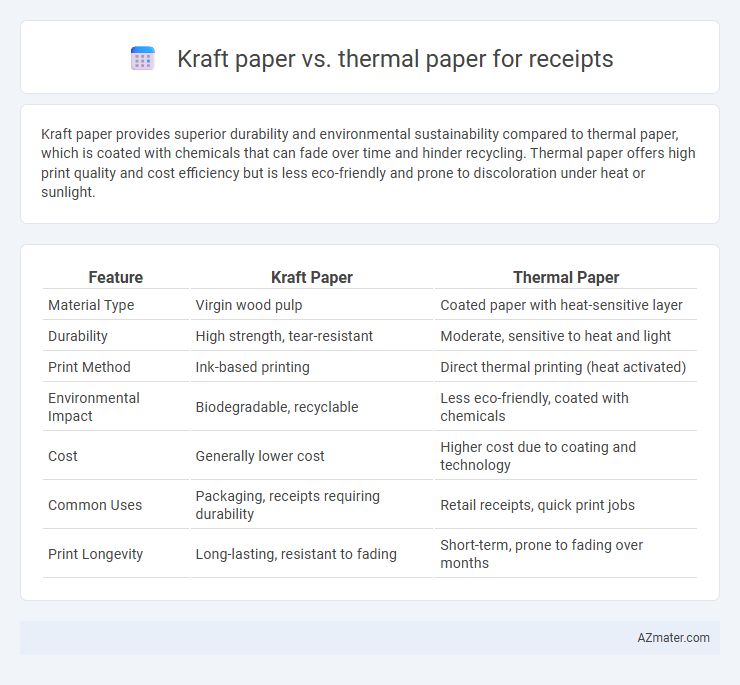Kraft paper provides superior durability and environmental sustainability compared to thermal paper, which is coated with chemicals that can fade over time and hinder recycling. Thermal paper offers high print quality and cost efficiency but is less eco-friendly and prone to discoloration under heat or sunlight.
Table of Comparison
| Feature | Kraft Paper | Thermal Paper |
|---|---|---|
| Material Type | Virgin wood pulp | Coated paper with heat-sensitive layer |
| Durability | High strength, tear-resistant | Moderate, sensitive to heat and light |
| Print Method | Ink-based printing | Direct thermal printing (heat activated) |
| Environmental Impact | Biodegradable, recyclable | Less eco-friendly, coated with chemicals |
| Cost | Generally lower cost | Higher cost due to coating and technology |
| Common Uses | Packaging, receipts requiring durability | Retail receipts, quick print jobs |
| Print Longevity | Long-lasting, resistant to fading | Short-term, prone to fading over months |
Introduction to Receipt Paper Types
Receipt paper types primarily include Kraft paper and Thermal paper, each serving distinct purposes in point-of-sale systems. Kraft paper is known for its durability and eco-friendliness, often used for printing receipts requiring longer preservation or resistance to wear. Thermal paper, widely used for its fast and quiet printing capabilities, utilizes heat-sensitive coatings that eliminate the need for ink ribbons, making it ideal for high-volume retail environments.
What is Kraft Paper?
Kraft paper is a strong, coarse paper made from wood pulp through the kraft process, offering high durability and resistance to tearing, making it ideal for receipts requiring long-lasting records. Its natural brown color and eco-friendly properties differentiate it from thermal paper, which relies on heat-sensitive coatings for immediate print visibility but tends to fade over time. Kraft paper receipts are better suited for archival purposes and environments where chemical exposure or heat can degrade thermal paper.
What is Thermal Paper?
Thermal paper is a specially coated paper designed to change color when exposed to heat, eliminating the need for ink or ribbons in receipt printing. It offers fast, quiet printing and is commonly used in point-of-sale (POS) systems due to its efficiency and cost-effectiveness. Unlike Kraft paper, thermal paper produces crisp, clear text and images but can be sensitive to heat, light, and moisture, affecting its longevity.
Printing Methods: Kraft vs Thermal
Kraft paper for receipts typically uses impact printing methods such as dot matrix or thermal transfer, which require ink or ribbons to produce durable text and images. Thermal paper, on the other hand, is designed for direct thermal printing, where heat-sensitive coating on the paper reacts to thermal printer heads to form images without the need for ink. Thermal printing offers faster, quieter operation with higher print resolution, while Kraft paper's impact printing supports more durable and archival-quality receipts.
Durability and Longevity
Kraft paper receipts offer superior durability due to their thicker, fibrous composition, making them resistant to tearing, moisture, and general wear over time. Thermal paper receipts, while offering sharp print quality, tend to fade quickly when exposed to heat, light, or oils, significantly reducing their longevity. For long-term record-keeping, Kraft paper is preferred due to its robustness and resistance to environmental factors.
Environmental Impact and Recyclability
Kraft paper is made from natural wood fibers, making it biodegradable and easier to recycle compared to thermal paper, which often contains chemical coatings like BPA or BPS that hinder recycling processes and pose environmental hazards. Thermal paper waste contributes significantly to landfill pollution due to its non-biodegradable chemical layer, whereas kraft paper receipts break down more effectively and have a lower carbon footprint. Choosing kraft paper for receipts supports sustainable business practices and reduces long-term environmental impact through improved recyclability and reduced toxic waste.
Cost Comparison
Kraft paper typically offers a lower upfront cost compared to thermal paper, making it a budget-friendly option for receipt printing. However, thermal paper's higher initial expense is offset by its durability and no need for ink or toner, reducing long-term operational costs. Businesses must weigh the cheaper raw material price of kraft paper against the cost savings in maintenance and print quality of thermal paper.
Use Cases and Industry Preferences
Kraft paper is favored in retail and food industries for its durability and eco-friendly properties, making it ideal for receipts that need to withstand handling and environmental factors. Thermal paper is predominantly used in the hospitality and healthcare sectors due to its fast printing speed and high-quality print clarity, essential for quick transaction processing and legibility. Industry preferences depend on factors like print longevity, environmental conditions, and cost-efficiency, with thermal paper dominating high-volume, fast-paced environments and kraft paper preferred for sustainable, rugged applications.
Health and Safety Considerations
Kraft paper receipts are free from BPA and other harmful chemicals, making them a safer choice for consumers concerned about chemical exposure and skin contact. Thermal paper often contains BPA or BPS, which are endocrine disruptors linked to health risks, raising concerns for frequent handling by cashiers and customers. Choosing BPA-free thermal paper or Kraft paper can reduce potential health hazards associated with receipt handling and environmental impact.
Choosing the Right Paper for Your Business
Choosing the right paper for your business receipts impacts both durability and customer experience; Kraft paper offers eco-friendly, tear-resistant qualities ideal for branding sustainability, while thermal paper provides crisp, cost-effective print quality suitable for high-volume transactions. Consider factors like print longevity, resistance to heat and moisture, and compatibility with your receipt printer to optimize operational efficiency. Evaluating these properties ensures the selected paper aligns with your business needs and environmental commitments.

Infographic: Kraft paper vs Thermal paper for Receipt
 azmater.com
azmater.com